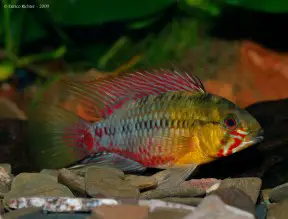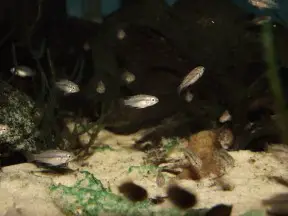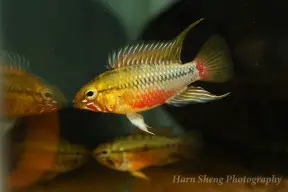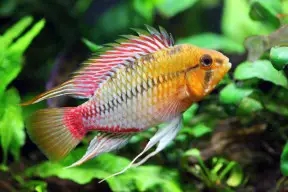Apistogramma hongsloi
Classification
Order: Perciformes Family: Cichlidae
Distribution
Known from the Río Vichada and middle Río Meta basins in Colombia, plus the middle section of the Orinoco system in Venezuela, of which both the Vichada and Meta are tributaries.
Habitat
Small tributaries and still waters
Maximum Standard Length
Males to 55 – 60 mm, females 40 – 45 mm.
Aquarium SizeTop ↑
Base dimensions around 45 ∗ 30 cm are acceptable for a single pair with a group requiring larger quarters.
Maintenance
Provided adequate cover and structure is available this species is unfussy with regards to décor with ceramic flowerpots, lengths of plastic piping and other artificial materials all useful additions. A more natural-looking arrangement might consist of a soft, sandy substrate with wood roots and branches placed such a way that plenty of shady spots and caves are formed.
The addition of dried leaf litter (beech, oak or Ketapang almond leaves are all suitable) would further emphasise the natural feel and with it bring the growth of beneficial microbe colonies as decomposition occurs. These can provide a valuable secondary food source for fry, while the tannins and other chemicals released by the decaying leaves aid in simulation of naturalistic conditions. Leaves can be left in the tank to break down fully or removed and replaced every few weeks. A net bag filled with aquarium-safe peat can also be added to the filter or suspended over the edge of thetank.
Fairly dim lighting is recommended and plant species from genera such as Microsorum, Taxiphyllum, Cryptocoryne andAnubias are best since they will grow under such conditions. A few patches of floating vegetation to diffuse the light even further may also prove effective. Filtration, or at least water flow, should not be very strong and very large water changes are best avoided with 10-15% weekly adequate provided the tank is lightly-stocked.
Water Conditions
Temperature: 23 – 29 °C
pH: 5.5 – 7.0
Hardness: 18 – 268 ppm
Diet
Primarily carnivorous and feeds mostly on benthic invertebrates in nature. In the aquarium live and frozen foods such asArtemia, Daphnia and chironomid larvae (bloodworm) should be offered regularly although most specimens will also learn to accept dried alternatives with pelleted products generally preferred to flake.
Behaviour and CompatibilityTop ↑
Captive-raised fish are the recommended choice for the community aquarium. Wild examples are best maintained alone or with small ‘dither’ fishes such as Nannostomus or Micropoecilia spp., and ideally should not be mixed with other Apistogramma.
Sexual Dimorphism
Males are larger, more colourful and develop more extended fins than females.
Reproduction
Substrate spawner which normally lays its eggs in crevices or cavities among the décor. The female is responsible for post-spawning care of eggs and fry and in smaller aquaria the male may need to be removed as she may become hyper-aggressive.
NotesTop ↑
This species is assigned the code A110 under the DATZ ‘A-number’ system, with similar-looking, possibly conspecific populations referred to as A111, A112, A113, A114 or A115 depending on collection locality.
The genus Apistogramma is among the most speciose of South American cichlid genera with around 70 species valid at present but many more awaiting description. In addition many species exist in two or more geographical colour forms which may or may not turn out to be distinct in the future. Hobbyists tend to label these with collection data if available in order to avoid mixing them and the potential of hybridisation.
Member species have also been organised into a series of species lineages, sublineages, complexes and groups by authors in order to better separate them. Such lists have been augmented by fish that have appeared in the aquarium trade and are in a state of near-constant flux. For example, A. hongsloi is included in the A. hongsloi complex which forms the A. macmasteri group alongside the A. macmasteri complex. This combined group is additionally contained within the larger A. regani lineage.
Kullander (1998) conducted a morphology-based phylogenetic study in which the neotropical family Cichlidae was divided into six subfamilies of which the putative subfamily Geophaginae contained 16 genera divided among three ‘tribes’:
Acarichthyini – Acarichthys and Guianacara.
Crenicaratini – Biotoecus, Crenicara, Dicrossus and Mazarunia.
Geophagini – Geophagus, Mikrogeophagus, ‘Geophagus‘ brasiliensis group, ‘Geophagus‘ steindachneri group, Gymnogeophagus, Satanoperca, Biotodoma, Apistogramma, Apistogrammoides and Taeniacara.
Later molecular studies by Farias et al. (1999, 2000, 2001) resulted in the additions of Crenicichla and Teleocichla to the Geophaginae, a result supported by López-Fernández et al. (2005) who conducted the most detailed molecular analysis of the grouping to date including 16 of the 18 genera and 30 species. However their conclusions regarding interrelationships between genera did vary somewhat from previous hypotheses and can be summarised by the following loosely-defined groups:
– a weakly-supported sister group relationship between Acarichthys and Guianacara.
– a well-supported “Satanoperca clade” comprising Satanoperca, Apistogramma, Apistogrammoides and Taeniacara.
– a “big clade” with Geophagus, Mikrogeophagus, ‘Geophagus‘ brasiliensis group, ‘Geophagus‘ steindachneri group,Gymnogeophagus, Biotodoma, Crenicara and Dicrossus.
– a “crenicarine clade” with Biotoecus and Crenicichla.
No representatives of Teleocichla or Mazarunia were included in the study but the former is well-established as sisterto Crenicichla while the latter has grouped closely with Dicrossus and Crenicara in earlier works. The other main conclusions of the paper are confirmation that Geophaginae is a monophyletic group exhibiting strong signs of having undergone rapid adaptive radiation (diversification of a species or single ancestral type into several forms that are each adaptively specialised to a specific environmental niche).






September 28th, 2013 at 10:45 pm
Just a few beginner’s observations that may help other beginners willing to give this beautiful fish a go:
1. When buying, do not be discouraged by the fact that fish are grey and plain looking. They will display their colours once put in a sensibly arranged tank.
2. When decorating your tank, provide plenty of cover and break lines of sight, particularly at the bottom of the tank where Apistos like to spend their time. This is because the male may chase the female with real persistence sometimes, especially when he is eager to display and spawn and she is not ready. I recall rearranging a 60×30 cm tank for that very reason. The profile suggests 45×30 is sufficient but I would imagine getting the layout right is even trickier then. A dark cave is the ultimate hideout, and having one nearby will increase female’s comfort of living. It will also be the likely place to lay eggs.
3. In a community tank ensure that your hongsloi are getting enough food, they like to examine the food and take their time with it. When housed with many smaller, fast swimming fish, they may struggle to get more then a mouthful or two – they are simply not quick and agile enough to compete. Feeding small cichlid pellets that sink quickly and are not appealing to dither fish solves that problem.